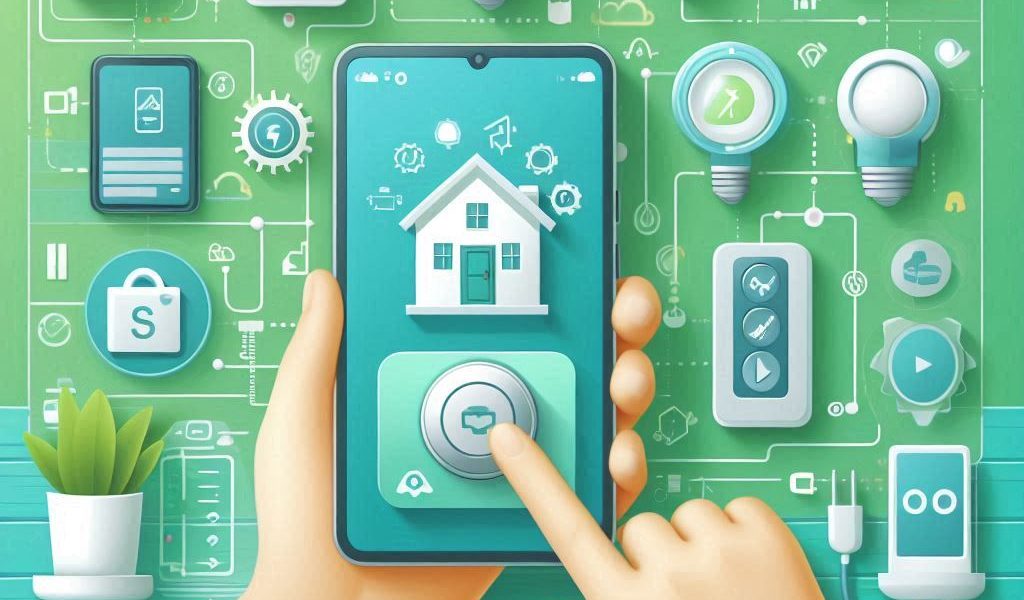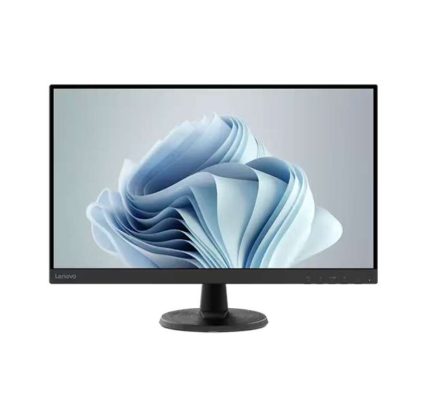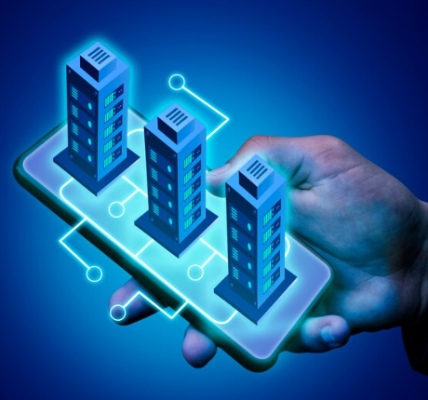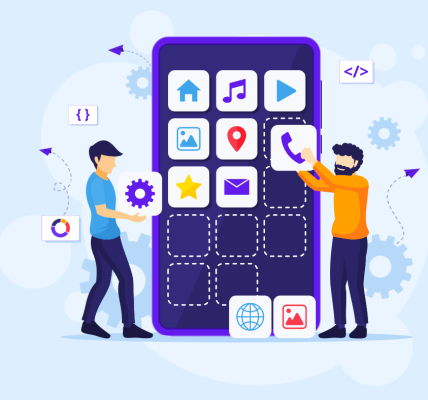Introduction:
Our homes are getting smarter, and the apps that control them are evolving right alongside. If you’re looking to stay ahead of the curve in home automation app development, here are some key trends to watch:
Voice Control Reigns Supreme: People are increasingly ditching buttons and embracing voice assistants like Alexa and Google Assistant. Your app should integrate seamlessly with these popular platforms, allowing users to control their homes with simple voice commands.
Energy Efficiency on Point: Sustainability is a major concern, and homeowners are looking for ways to save energy. Smart home apps can help by offering features like automated light scheduling, remote thermostat control, and real-time energy usage monitoring.
Security Gets Smarter: Peace of mind is priceless. Apps are incorporating advanced security features like remote video monitoring, smart door lock integration, and real-time alerts for suspicious activity.
The Rise of Personalization: A cookie-cutter approach won’t cut it anymore. Look for ways to personalize the user experience. This could include creating custom automation routines, setting up geofencing triggers (actions based on location), and allowing users to define their ideal smart home environment.
Interconnectivity is Key: The future of smart homes lies in connected devices working together. Your app should play a central role in this ecosystem, enabling smooth communication between various smart appliances and creating a truly unified experience.
By incorporating these trends, you can develop home automation apps that are not only functional but also enhance users’ lives and make their homes more comfortable, secure, and efficient.
Top Trends in Home Automation App Development
1. Focus on User Experience (UX) and User Interface (UI):
The smart home market is booming, but with an ever-growing number of devices and apps, user experience (UX) and user interface (UI) become paramount for success. Here’s how to prioritize UX and UI in your home automation app development:
UX: Designing for Simplicity and Delight
User Research is Key: Understand your target audience. What are their needs, expectations, and pain points when it comes to controlling their smart home? Conduct user research through surveys, interviews, and usability testing to gather valuable data.
Prioritize User Flow: Map out the user journey within your app. Every interaction should be intuitive and efficient. Users should be able to easily discover features, complete tasks with minimal steps, and troubleshoot any issues without frustration.
Personalization is Power: Empower users to create a smart home environment that reflects their preferences. Allow for custom automation routines, personalized dashboards, and easy control over device settings.
Voice Control for Seamless Interaction: Integrate with popular voice assistants like Alexa and Google Assistant. This allows users to control their home hands-free, enhancing accessibility and convenience.
UI: Creating a Visually Appealing and Functional Interface
Clean and Intuitive Design: Prioritize a clean and uncluttered interface. Use clear icons, consistent layouts, and easy-to-read fonts. Everything should be visually intuitive, allowing users to understand the app’s functionality at a glance.
Accessibility Matters: Ensure your app is accessible to everyone. Incorporate features like high-contrast themes, larger font size options, and voice control for users with visual impairments.
Real-time Feedback and Guidance: Provide clear feedback mechanisms throughout the app. Let users know when actions are being performed and offer helpful guidance within the interface itself.
Embrace the Power of Visuals: Use high-quality icons, informative graphics, and intuitive animations to enhance the user experience and make interacting with the app a visually pleasing experience.
By focusing on UX and UI, you can create a home automation app that is not only feature-rich but also a joy to use. This will lead to higher user satisfaction, increased engagement, and a more successful smart home product in the marketplace.
2. Enhanced Security and Privacy:
The convenience of a smart home comes with the responsibility of safeguarding user data and ensuring the security of connected devices. In today’s digital landscape, building trust with users requires a focus on enhanced security and privacy within your home automation app. Here’s how to prioritize these crucial aspects:
Security: Building a Fortress Around User Data
Robust Encryption: Implement industry-standard encryption protocols to protect user data, both in transit and at rest. This safeguards sensitive information like login credentials, device information, and usage patterns.
Multi-Factor Authentication: Go beyond simple passwords. Enforce multi-factor authentication (MFA) that requires an additional verification step, like a fingerprint scan or a one-time code, to access the app and control smart devices.
Regular Security Updates: Proactive security is key. Patch vulnerabilities promptly by issuing regular app updates that address any security concerns identified. Communicate these updates clearly to users.
Network Security: Ensure secure communication between the app, user devices, and the smart home network. Utilize secure protocols and consider implementing a separate network specifically for smart home devices to minimize potential risks.
Privacy: Putting Users in Control of Their Data
Transparency is Key: Be transparent about the data your app collects and how it’s used. Provide clear and concise privacy policies that users can easily access and understand.
User Consent Matters: Obtain explicit user consent before collecting any personal data. Allow users to control the data they share and give them the option to opt out of data collection features.
Data Minimization: Collect only the data essential for the app’s functionality. Avoid unnecessary data-gathering practices that could raise privacy concerns.
Secure Data Storage: Store user data securely using industry-approved methods. Implement measures to prevent unauthorized access and data breaches.
By prioritizing enhanced security and privacy, you can build trust with your users and establish your home automation app as a reliable and secure solution. This will foster a sense of confidence and encourage wider adoption of your smart home product.
3. Integration with the Internet of Things (IoT):
The magic of smart homes lies in seamlessly connected devices working together. This symphony of intelligence is orchestrated by integration with the Internet of Things (IoT). Here’s how to ensure your home automation app excels at connecting with the vast landscape of IoT devices:
Unlocking the Power of IoT Ecosystems:
Standardized Protocols: Ensure your app adheres to widely adopted IoT communication protocols like Zigbee, Z-Wave, or Bluetooth Low Energy. This allows for smooth integration with a broader range of smart devices from various manufacturers.
Open APIs and Developer Tools: Embrace open application programming interfaces (APIs) and provide robust developer tools. This empowers third-party developers to create innovative integrations with your app, expanding the functionality and compatibility of your smart home ecosystem.
Cloud Connectivity: Leverage the power of cloud platforms to facilitate communication between your app, user devices, and the vast network of IoT devices. This enables remote access, real-time data exchange, and centralized control for a truly connected smart home experience.
Future-Proof Design: The IoT landscape is constantly evolving. Design your app with scalability in mind to accommodate future advancements and the integration of new and emerging IoT devices.
Building a Seamless User Experience:
Device Discovery and Onboarding: Streamline the process of adding new devices to the app. Make device discovery and onboarding a user-friendly experience with clear instructions and intuitive interfaces.
Automated Routines and Rules: Allow users to create custom automation routines and rules that leverage the connectedness of IoT devices. This could involve setting lights to automatically adjust based on room occupancy or triggering the thermostat based on sensor data.
Unified Dashboard and Control: Provide a central dashboard within your app that offers a holistic view of all connected devices. This empowers users to easily monitor device status, adjust settings, and control their smart home from one central location.
By prioritizing integration with the IoT, your home automation app can transform from a simple app to the brain of a truly intelligent home. This seamless connectivity creates a more convenient, efficient, and personalized smart home experience for users.
4. Energy Efficiency and Sustainability:
The rise of smart homes presents a unique opportunity to combine convenience with environmental responsibility. Home automation apps can play a pivotal role in promoting energy efficiency and fostering a more sustainable lifestyle. Here’s how to leverage your app to empower users to make eco-conscious choices:
Optimizing Energy Consumption:
Smart Climate Control: Integrate with smart thermostats that learn user preferences and adjust heating and cooling automatically. This reduces unnecessary energy waste and lowers utility bills. Offer features like geofencing to automatically adjust temperatures based on occupancy.
Automated Lighting Management: Promote the use of energy-efficient LED bulbs and integrate with smart lighting systems. Allow users to schedule lighting based on sunrise and sunset or utilize motion sensors to ensure lights are only on when needed.
Real-Time Energy Monitoring: Provide users with real-time data on their home’s energy consumption. This empowers them to identify areas for improvement and make informed decisions to optimize energy usage.
Appliance Management: Integrate with smart appliances to enable remote control and monitoring. This allows users to schedule energy-intensive tasks for off-peak hours or receive alerts when appliances are left running unnecessarily.
Encouraging Sustainable Practices:
Water Management Integration: Connect with smart irrigation systems to optimize water usage for lawns and gardens. Integrate with weather data to adjust watering schedules based on real-time conditions.
Renewable Energy Support: Explore ways to integrate with renewable energy sources like solar panels or home wind turbines. Provide users with data on energy generation and allow them to monitor their progress towards energy independence.
Sustainable Lifestyle Tips: Offer informative content within the app that promotes sustainable living practices. This could include tips on reducing energy consumption, responsible water usage, or recycling best practices.
By incorporating these features, your home automation app can become a powerful tool for energy efficiency and sustainability. This empowers users to take control of their energy consumption, reduce their environmental impact, and create a more eco-friendly home.
5. Focus on Wellbeing and Health:
By incorporating features that prioritize user health and create a nurturing atmosphere, you can transform your smart home app into a true wellness partner.
Cultivating a Restful Haven:
Sleep Optimization with Smart Lighting: Integrate with smart lighting systems that mimic natural light patterns. Allow users to schedule a gradual dimming sequence in the evening, promoting better sleep by aligning with natural circadian rhythms.
Personalized Relaxation Routines: Design pre-programmed routines that foster relaxation before bed. These could involve dimming lights, adjusting thermostats for optimal sleep temperatures, and playing calming music or white noise.
Air Quality for Enhanced Sleep: Connect with smart air purifiers and air quality sensors. This empowers users to monitor and improve indoor air quality, a significant factor impacting sleep and overall well-being.
Encouraging a Healthy Lifestyle:
Automated Fitness Motivators: Allow users to set personalized reminders for exercise or healthy activities. Integrate with wearable fitness trackers to track progress and offer motivational feedback for achieving fitness goals.
Smart Nutrition and Hydration Support: Connect with smart refrigerators or pantry management systems to provide users with insights into their food inventory. Offer recipe suggestions based on available ingredients or gentle reminders to stay hydrated throughout the day.
Stress Management Features: Integrate with meditation apps or relaxation tools like white noise generators and calming nature sounds. Offer guided meditation routines or breathing exercises to help users manage stress and promote mental well-being.
Personalization for a Holistic Approach:
Learn User Habits and Preferences: Leverage machine learning to gain insights into user habits and preferences. This allows for personalized recommendations for sleep routines, exercise reminders, or healthy meal suggestions.
Seamless Integration with Wellness Devices: Facilitate seamless connection with a wide range of health and wellness devices like smart scales, blood pressure monitors, or sleep trackers. Present this data in a clear and actionable way within the app.
Focus on Preventative Care: Offer features that encourage preventative healthcare practices. This could include reminders for medication adherence, scheduling doctor appointments, or providing resources for healthy living practices.
By incorporating these features, your smart home app goes beyond automation. It becomes a valuable tool for creating a personalized wellness haven, supporting users in their journeys towards a healthier and more fulfilling life. This focus on well-being sets your app apart and positions it as a trusted partner in users’ quest to live their best lives.
The Future of Home Automation App Development
The smart home revolution is rapidly evolving, and the apps that control these intelligent living spaces are at the forefront of innovation. To stay ahead of the curve, let’s explore what the future holds for home automation app development:
AI Ushers in a New Era of Personalization:
Proactive Automation: Imagine an app that anticipates your needs. Advanced AI will learn user routines and preferences, automatically adjusting lighting, temperature, or even playing music based on the time of day or activity detected.
Context-Aware Intelligence: The app will understand the context of a situation. For example, dimming lights and adjusting the thermostat for movie night, or automatically locking doors and activating security features when you leave.
Voice Control Gets Even Smarter: Natural language processing will allow for more nuanced and natural voice interactions. Imagine saying “good night” to turn off lights, adjust the thermostat, and lock doors, all with a single command.
The Rise of Interconnected Ecosystems:
Seamless Device Integration: The future lies in a universe of connected devices working together flawlessly. Your app will act as the central hub, seamlessly integrating smart appliances, wearables, and even healthcare devices to create a truly unified smart ecosystem.
Open Standards and Interoperability: Standardized protocols will ensure all devices, regardless of brand, can communicate and work together within your app. This fosters a wider range of choices and a more open and flexible smart home experience.
Focus on Wellbeing and Ambient Intelligence: The future of smart homes goes beyond convenience. Apps will leverage AI and connected devices to create an environment that actively promotes user well-being. Imagine lights adjusting to optimize sleep patterns or the thermostat automatically creating a calming atmosphere.
By embracing these trends, developers can create home automation apps that are not just feature-rich but truly intelligent and adaptive. These future-proof apps will transform homes into responsive environments that cater to our individual needs and enhance our lives in profound ways.
Conclusion:
The future of home automation app development is bright, and the apps that control them are at the center of this transformation. By staying informed about the latest trends in home automation app development, you can create user-centric applications that are not only convenient but also secure, sustainable, and personalized. So, dive into the exciting world of smart home app development and be a part of shaping the future of how we live.
FAQ:
1. What are the latest trends in home automation app development?
Q: What are the latest trends in home automation app development?
A: The latest trends in home automation app development include the integration of artificial intelligence (AI) and machine learning, enhanced security features, voice-controlled systems, energy management solutions, and interoperability with various smart devices. AI and machine learning help in predictive maintenance and personalized user experiences. Enhanced security ensures safe data transmission and device control. Voice assistants like Amazon Alexa, Google Assistant, and Apple’s Siri are becoming central to controlling smart homes. Energy management solutions help in monitoring and optimizing energy use. Interoperability ensures that devices from different manufacturers can work seamlessly together.
2. How is artificial intelligence improving home automation apps?
Q: How is artificial intelligence improving home automation apps?
A: Artificial intelligence is revolutionizing home automation apps by enabling more intuitive and efficient control systems. AI can analyze usage patterns and learn from them, allowing the system to anticipate user needs and automate tasks accordingly. For instance, AI can automatically adjust lighting and temperature based on the time of day or occupancy. Additionally, AI-powered home automation systems can provide predictive maintenance alerts, suggesting when appliances might need servicing before they fail, and enhance security by identifying unusual activities and alerting homeowners.
3. Why is interoperability important in home automation systems?
Q: Why is interoperability important in home automation systems?
A: Interoperability is crucial in home automation systems because it ensures that devices from different manufacturers can work together seamlessly. This integration allows users to control all their smart home devices through a single app or platform, providing a unified and convenient user experience. Without interoperability, users would need separate apps for each device, leading to fragmentation and reduced usability. It also allows for more comprehensive automation scenarios, where multiple devices can interact to create a smarter, more efficient home environment.
4. What role do voice assistants play in home automation?
Q: What role do voice assistants play in home automation?
A: Voice assistants play a significant role in home automation by providing a hands-free, intuitive way to control smart home devices. Popular voice assistants like Amazon Alexa, Google Assistant, and Apple’s Siri allow users to issue voice commands to control lights, thermostats, security systems, entertainment systems, and more. This integration makes home automation more accessible, especially for individuals with disabilities or those who prefer voice interaction over manual controls. Voice assistants also enable complex automation routines, where multiple devices can be controlled with a single command.
5. How are home automation apps enhancing security features?
Q: How are home automation apps enhancing security features?
A: Home automation apps are enhancing security features by incorporating advanced technologies such as biometric authentication, end-to-end encryption, and real-time monitoring. Biometric authentication, including fingerprint and facial recognition, ensures that only authorized users can access the system. End-to-end encryption protects data transmitted between devices from being intercepted or tampered with. Real-time monitoring features allow homeowners to view live feeds from security cameras, receive instant alerts for suspicious activities, and remotely lock or unlock doors. These enhancements provide a higher level of security and peace of mind for users.





